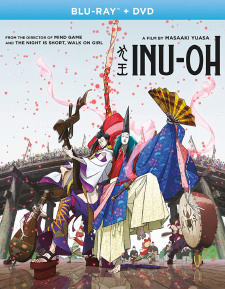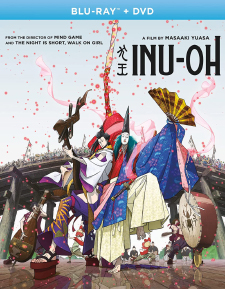Inu-Oh (Blu-ray Review)

Director
Masaaki YuasaRelease Date(s)
2021 (January 24, 2023)Studio(s)
Science SARU (GKIDS/Shout! Factory)- Film/Program Grade: B
- Video Grade: A-
- Audio Grade: A-
- Extras Grade: C+
Review
Masaaki Yuasa’s Inu-Oh is a fascinating clash between traditional methods of storytelling and modern sensibilities—it’s 14th century Sarugaku theatre reimagined as a rock opera. While Sarugaku was every bit as formalistic as other Japanese theatrical traditions such as Noh or Kabuki, it was nevertheless a bit freer in nature, mixing dance and pantomime with acrobatics and juggling into what was essentially a multimedia presentation akin to what Cirque du Soleil does today. It was popular entertainment, but one that became highly regulated under a guild system and the patronage of the shogunate. Like most forms of oral storytelling, it was a way of commemorating previous events that didn’t necessarily require literacy on the part of its listeners or viewers. The past was brought to vivid life for bygone audiences via dance and music, but now that the Sarugaku era is itself a thing of the past, Yuasa chose to bring it back to life for modern audiences within a contemporary musical idiom.
Appropriately enough for a film that mixes styles, Inu-Oh is based on a mélange of sources. It’s an adaptation of the 2020 novel Tales of the Heike: Inu-Oh (aka Heike Monogatari: Inu-Ō no Maki) by Hideo Furukawa. Furukawa was inspired by the fourteenth-century compilation Heike Monogatari, which told the epic tale of the struggle between two clans during the twelfth-century Genpei War, a conflict that ended up reshaping the political structure of Japan. While the original work had been translated into modern Japanese many times, Furukawa participated in a freer translation in 2016, one that used contemporary vernacular. He delved into his own translation as the primary source for Inu-Oh. Akiko Nogi’s screenplay for the film treats the entire historical background elliptically, choosing instead to focus on the performers who told the tale. The deformed Inu-Oh (Japanese rock star Avu-chan) is forced to live at the margins of society until he ends up befriending the blind biwa player Tomona (Mirai Moriyama). The two end up teaming up to tell the stories of the Heike in their own unique style, one that draws adoring crowd, but it also draws unwelcome attention from shogunate—at great personal cost to both of them.
Masaaki Yuasa chose to heighten the tension between traditional storytelling and contemporary rock music by animating Inu-Oh in a hand-drawn style that mimics the look of classical Japanese woodcuts and watercolors. Modern digital animation has afforded the opportunity for filmmakers to create a three-dimensional sense of depth, but Yuasa primarily kept things flat and two-dimensional. Some shots mimic the effect of cel animation performed with a multiplane camera, with individual elements being stacked in depth, but the elements themselves are still flattened. Toward the end, he does break with that style to offer a few 3D backgrounds as well, possibly to indicate the way that Inu-Oh and Tomona’s music has broken with tradition. It’s still a strikingly consistent style for most of the film, one that pays respects to the traditions of the animators who have preceded Yuasa. There’s a touch of Gerard Scarfe in a few shots, and more than a touch of Ralph Bakshi (especially in regards to American Pop). Yuasa even experimented with using static fabric textures behind moving characters, just like Mahiro Maeda did for the series Gankutsuou: The Count of Monte Cristo. There’s a sense of the old mingled with the new all throughout Inu-Oh, at every possible level.
In the end, the one thing that hasn’t changed from the fourteenth century to today is the way that traditions can stifle creativity, and the price that is often paid by those who choose to break free from those artificial strictures. Given the fact that rock music has itself been a form of rebellion against the traditions that came before, it makes perfect sense that Yuasa treated Inu-Oh and Tomona as rock stars who find themselves in conflict with society. As a film, Inu-Oh can be difficult to follow at times, especially to anyone unfamiliar with the historical details—this is one case where a little advance research about the period can help make things clearer to first-time viewers. Yet the historical backdrop is just that: a backdrop. The core story of Inu-Oh is about the conflict between artists who just want to express themselves in their own ways, and societies that aren’t willing to accept anything that breaks with norms. Regardless of era or setting, that’s something truly universal.
Inu-Oh was animated digitally, primarily using hand-drawn 2D elements, although there are indeed a small number of 3D backgrounds used for a few shots. Those 3D elements really stand out here more than they do in other films that mix the two, since the overall look of Inu-Oh is so flattened by design. The 2.39:1 framed image offers little depth for the majority of the film, and that’s a very intentional effect. Inu-Oh isn’t the brightest of films, with a muted color palette that once again recreates the look of traditional Japanese artwork. A few scenes do offer bursts of stronger colors when appropriate, but for the most part, it sticks with the limited palette. This presentation of Inu-Oh doesn’t necessarily offer the dazzle that digital animation can provide, as it really leans into the hand-drawn look of traditional cel animation, but it’s entirely accurate to the intentions of the filmmakers. It’s complex material to reproduce, but as has been typical for Shout! Factory/GKIDS releases of late, everything runs at a consistently high bit rate, so there’s no real issues with banding, noise, or other compression artifacts.
Audio is offered in Japanese and English 5.1 DTS-HD Master Audio, with optional English, English SDH, and Spanish subtitles. (The English subtitles match the Japanese language version, and the English SDH matches the English dub.) There’s also an English Descriptive Video Service track. While sub vs. dub is usually a matter of preference, in this case, the English language acting is a little too over-the-top, so the Japanese version is the recommended option between the two. Either way, while the mix for Inu-Oh is driven by its eclectic mixture of songs and musical score, the surrounds are still used to provide some effective immersion—literally so for the underwater sequences, where it really does sound like the viewer is immersed by the water. There’s also some occasional directionalized effects, like when voices swirl chaotically around the room in a few scenes. Still, Inu-Oh is all about the music, and that’s reproduced perfectly in this lossless presentation. The details from the various instruments are well-resolved, with some depth to the bass when it’s called for, and plenty of punch from the dynamics. It’s a great mix that supports the style of the film.
The Shout! Factory/GKIDS Blu-ray release of Inu-Oh is a two-disc set that includes a standard definition copy of the film on DVD, as well as a slipcover that duplicates the artwork from the insert. The following extras are included, all of them in HD:
- Interview with Masaaki Yuasa (12:02)
- Q&A at the U.S. Premiere (13:48)
- Yuasa Draws Inu-Oh (12:13)
- Scene Breakdown (24:03)
- Trailers and Teasers (5:39 – 5 in all)
In the brief Interview with Yuasa, he goes over many of the challenges that he faced in adapting the novel, and explains why he chose to include the modernistic elements. He also covers some of the technical challenges, like the fact that the dances were created before the songs were written. In Japan, the animation is usually completed before the voice acting is recorded, which requires the actors to match what’s happening onscreen. In this case, the same thing was done with the music. The Q&A at the U.S. Premiere took place at the American Cinematheque’s Aero Theatre in Santa Monica, and was moderated by Diaspora’s Dino-Ray Ramos. Yuasa laments that while performers preserved the stories of their times, no one preserved their own stories, and it’s only relatively recently that popular art forms have been recorded. He provides some of the backstory from the period that the film doesn’t, and talks about some of his inspirations, like Osama Tezuka’s Dororo. He admits that Inu-Oh requires multiple viewings in order to fully digest the narrative. Yuasa Draws Inu-Oh features the director explaining the character designs, and how they transform throughout the film. Finally, the Scene Breakdown has Yuasa going through the performance of the whale song toward the end of the film, explaining exactly what’s being conveyed through the music and the imagery.
Inu-Oh is yet another example of the limitless possibilities of the animation medium. No story is ever off the table, nor is any way of visualizing it, either. Masaaki Yuasa used animation to tell a traditional story in non-traditional fashion, and his work shines as presented on this Shout! Factory/GKIDS Blu-ray. Inu-Oh isn’t always an easy film to watch, especially for anyone without background knowledge of the period, but it’s essential viewing for those who love exploring the fringes of what animation can offer.
- Stephen Bjork
(You can follow Stephen on social media at these links: Twitter and Facebook.)

